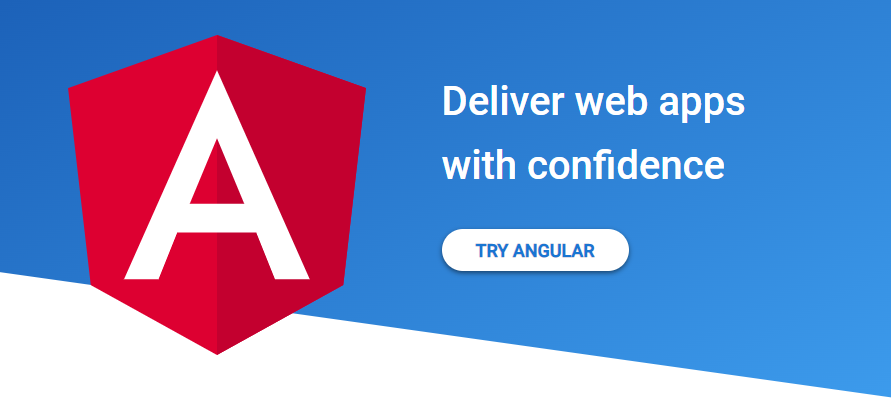Angular and Vue are some of the most popular frameworks for building user interfaces. With a lot of developers and companies using these frameworks in their applications, the debate often arises on which framework has more to offer compared to the other.
However, it is important to realize that both of these frameworks are just tools, and thus considerations should be put on what you want to build and then see the right tool for it. That said, let us dive into both of these frameworks to see which framework you should go for.
Introduction to Angular

Angular is a TypeScript-based open-source web framework developed and maintained by Google and used to build user interfaces in mobile and desktop web applications using JavaScript or TypeScript.
Angular was released in 2016 as the successor to Angular.js and has since grown to be the second most popular frontend framework; according to StackOverflow Developer Survey, 23 % of professional developers use Angular, while only 10 percent of developers learning to code use it.
Angular is designed for building Single Page Applications(SPAs). In traditional web applications, whenever a user interacts with a web page, a request is sent to the server, which sends back a new page, and thus each user interaction requires a full page reload.
However, with Single Page Applications, the entire web application operates on a single page where content is dynamically updated as the user interacts with the page. This enables the building of faster sites with better user experiences.
According to the Angular team at Google, Angular provides developers with all the tools they need to build powerful scalable applications with ease. Additionally, special emphasis is put on providing tools that reduce decision fatigue and enhance the productivity of developers, such as Angular’s powerful command line interface.

The framework also emphasizes best practices right from the start and has a lot of built-in tools that make it easy to create scalable and maintainable applications without the need to install additional libraries, such as a routing library. Additionally, it has excellent documentation and community, and new versions are released regularly.
That said, Angular is a framework that has, for the longest time, received a lot of negativity from developers online complaining that the framework is verbose and very slow to ship new exciting features that can revolutionalize web development. This can be attributed to Angular focus on reliability and stability rather than being quick to implement new shiny features.
However, it is worth noting that there’s a great demand for this framework, and it is an excellent choice to learn if you’re hoping to get a job in front-end development.
A lot of companies would rather go with something that is reliable and stable compared to what is deemed exciting at the time. For instance, Netflix uses Angular, and you can be sure they do so for a very good reason.
Introduction to Vue.js

Vue.js, commonly known as just Vue, is a progressive open-source, incrementally-adoptable JavaScript framework for building user interfaces. Vue, which was publicly released in February 2014, was developed by Evan You, who was part of the team at Google that worked with Angular.
According to Evan, his motivation for creating Vue was that he didn’t like the design decisions that Angular imposes on its users, and he felt that Angular was too heavy and had too many features that they didn’t need. Therefore, he decided to build a really lightweight framework that had the features he liked in Angular.
Unlike Angular, which comes with prebuilt tools that developers use when building using the framework, Vue takes a different approach. Vue is made up of a core comprising just data binding and components which offer a very minimal feature set.
However, Vue offers officially maintained adaptable pieces such as a command line interface, a routing solution, and a build toolchain, among others which you can add to your application.
This allows you to start working with just the core features and then add whatever extra pieces of the framework you need as your application grows in complexity. Since Vue does not make the decisions for you on what features to use, Vue is a very versatile and flexible framework that is easy to scale and use in building highly performant applications. With Vue, there’s no need for manual code optimization, as it optimizes your code for you.
As much as Vue is a more recent framework and has not been developed by a big tech company like Angular, Vue is slowly earning its spot as a reliable and loved web development framework.
In fact, according to the StackOverflow Developer Survey in 2022, more developers learning to code are learning Vue compared to Angular. Additionally, more developers are interested in building using Vue compared to Angular, and Vue ranks higher on the most loved frameworks compared to Angular.
As much as Angular and Vue may be worlds apart in their approach to the development of user interfaces, these two frameworks share some similarities. Let us dive into some of these similarities.
Angular vs. Vue: Similarities
Some of the areas where Angular and Vue have similarities include:
Component-Based Architecture

Component-based architecture is a software design pattern where software is broken into smaller, reusable, and self-contained building blocks called components. Each component has a specific function and is independent of other components.
Rather than working to build the software as a whole, developers build components that are then combined to form a more complex application. These components can be reused at any point in the application.
Both Angular and Vue follow a component-based architecture in building user interfaces. When using these frameworks, user interfaces are broken down into independent reusable components that can be built in isolation and then put together to create a functional user interface for an application.
Reactive Data Binding
Reactive data binding involves binding your data with your view. This way, your data model is automatically synchronized with your views.
This way, any changes made to the data model are reflected in your view in real-time, and any changes made to the view are reflected in the data models without you needing to manually manipulate the document object model. Both Vue and Angular have support for reactive data binding.
Syntax

As much as there are differences in syntax since Vue and Angular are completely different frameworks, both of these frameworks share a similarity in the declarative programming style.
When using both of these frameworks, rather than giving the steps that are to be followed to achieve a certain goal, which is the imperative style of programming, you only need to describe what goal is to be achieved. This is known as declarative programming.
Community
Both of these frameworks have large communities of developers who are building using the frameworks. These communities are responsible for improving the frameworks by suggesting features to be added, removed, or tweaked.
The communities behind these frameworks are also responsible for the maintenance of the frameworks, giving feedback on the framework, building upon and improving the frameworks, and also providing support to other users.
Having covered the similarities between the two frameworks, lets us now look at their differences.
Angular vs. Vue: Differences
Some of the differences between these two frameworks include:
Language
Angular is a TypeScript-based framework, and thus developers have to use TypeScript when using the framework. Vue.js, on the hand, uses JavaScript but also offers official and first-class support for TypeScript.
Developers have the flexibility to use JavaScript or TypeScript when working with Vue. On this metric, as much as it may mean a longer time to pick up Angular as you have to first learn TypeScript, it is the better alternative, as TypeScript can significantly reduce the errors in your application. Additionally, TypeScript catches errors in development, and you’ll thus avoid costly errors in production. H
Learning Curve
One of the reasons a lot of developers love the Vue framework is because of how easy it is to learn and use it.
According to Evan You, who created Vue, Vue was developed, with approachability in mind, so that developers with only a basic understanding of HTML, CSS, and JavaScript can learn the framework easily. True to his word, Vue is one of the easiest UI frameworks to learn.
Angular, on the other, is much more difficult to pick up, and it will take you way longer to understand and use it. If you were simply to pick a framework based on how easy it will be to learn it, then go for Vue.
Performance
When it comes to performance, since Vue is a very lightweight framework, it offers better performance and faster speeds in applications compared to Angular. Vue’s performance can also be attributed to its use of a virtual Document Object Model(DOM). Manipulating the actual DOM is a very costly process performance-wise.
By using a virtual DOM, Vue reduces the number of actual manipulations to the real DOM. With Vue, the real DOM is only rendered upon components that have been changed and not the entire page. This has the benefit of making the rendering faster hence making Vue’s performance better.
Ecosystem and Tooling

When it comes to frameworks, the ecosystem refers to the tools and libraries available to the framework. Unlike Vue.js, Angular comes with a robust ecosystem with powerful built-in tools that make it easier to build, test and deploy Angular applications.
Vue’s ecosystem is not as robust as Angular, but Vue comes with officially supported tools that can be integrated into a Vue application as per the developer’s needs.
Additionally, Vue.js has a large set of third-party libraries, plugins, and add-ons that can be used to customize applications or streamline the development process.
Flexibility
As noted earlier, one of the reasons for the development of Vue is that Angular is very opinionated and makes a lot of decisions on behalf of the developer, giving them a structure, best practices, and guidelines they must work with. In that regard, Vue offers more flexibility and is less opinionated as compared to Angular.
Vue supports components that developers can integrate and use to customize their applications as they please at any stage of their development. If flexibility is an important factor, Vue is the obvious choice as it is easily adaptable to any project.
However, it is worth noting that a lot of big enterprises value the clearly defined structure that Angular comes with, as it allows for building more stable applications.
Scalability
If you’re building a large-scale application and are thus interested in a framework that offers excellent and out-of-the-box support for scalability, the obvious pick for you is Angular. Unlike Vue, Angular is built with scalability in mind, and it is a framework that is designed to allow teams to scale up easily.
Angular provides built-in tools and libraries that support scaling applications. This explains why a lot of large-scale applications, such as Netflix, are built with Angular. As much as Vue.js also supports scaling, it is much harder to scale with Vue, and it might require complex strategies when to scale when using the framework.
Development Speed
If you were to develop the same application using Angular and Vue, you’d take a much shorter time to develop the application using Vue. Angular takes a significantly longer time to develop applications because it is a very comprehensive framework and also very verbose.
Conversely, Vue offers significantly shorter development times because it is easier to write and read code, and the framework does not require as much boilerplate code as Angular.
Vue also uses templates written in standard HTML, and this may be faster to write as developers are more familiar with HTML than the additional Angular-specific syntax for writing templates in Angular.
Angular vs. Vue.js: Summarized
The table below shows the main differences between Angular and Vue.js:
| Angular | Vue.js | |
| Language | TypeScript is the primary and recommended language for building Angular applications. | Has official support for both JavaScript and TypeScript. |
| Learning Curve | Steep learning curve and requires a lot of time and effort to learn and use it. | Much easier to learn and use |
| Performance | Great performance and fast speeds, particularly with complex applications. | A robust ecosystem with lots of powerful built-in tools for development. |
| Ecosystem & Tooling | A robust ecosystem with powerful built-in tools. | Less robust ecosystem and fewer built-in tools, but has lots of third-party add-ons. |
| Flexibility | Very limited flexibility | Offers lots of flexibility |
| Scalability | Easy to scale and has built-in support for scaling. | Scaling is much harder to achieve and requires complex strategies. |
| Development Speed | Development speed is very slow. | Offers fast development speeds. |
Companies using Angular or Vue
A good way to gauge how good a framework and how employable it might make you is to look at the companies using the frameworks.
Some of the big companies using Angular include:
- Netflix
- Microsoft
- Paypal
- Deutsche Bank
- Tesla
- Forbes
- Freelancer
- Wise
- Santander
Some of the big companies using Vue.js include:
- Adobe
- Gitlab
- Behance
- Dribble
- Euronews
- Trivago
- Nintendo
- Euronews
- Xiaomi
- Alibaba
Angular and Vue.js are used by very large companies indicating that both of these frameworks are excellent tools to learn as far as employability is concerned. You need not worry about either of the frameworks not having demand for developers in the coming years.
Conclusion
As earlier stated, Vue and Angular are both tools that can be used to build the user interface of applications. Your decision on what tool to go for should be pegged on what you want to achieve and what you’re looking for in a framework.
If you’re looking for a flexible framework that is easy to learn and implement and offers highly performant applications, Vue.js is the obvious choice. If you’re building a complex large-scale application and thus need a stable application that is both fast and easy to scale, then Angular should be your go-to tool.
You may also read differences between React and Angular, the popular tools for web application development

